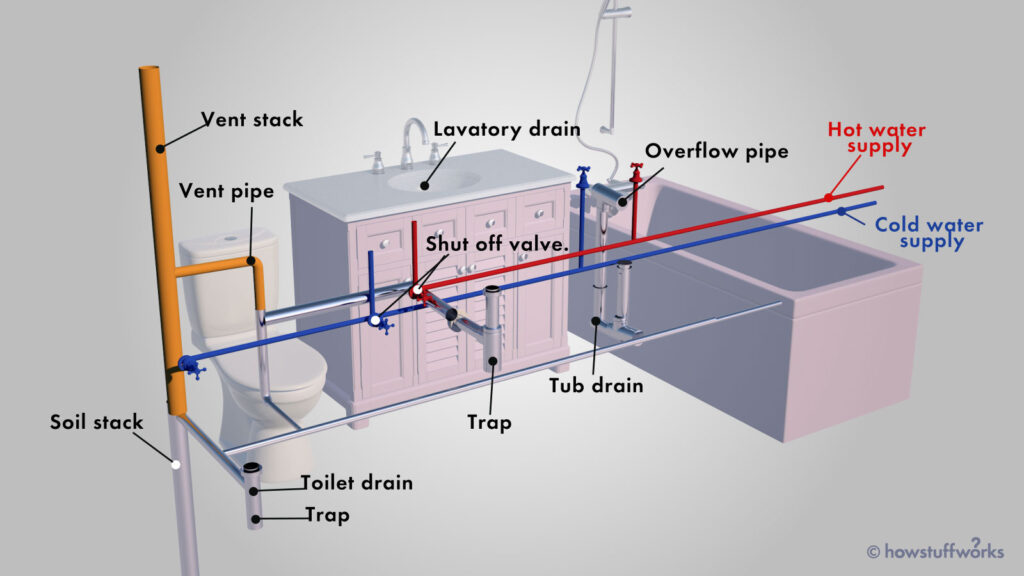
Living in an apartment offers many conveniences, but it also means sharing certain resources with your neighbors. One of these shared resources is the plumbing system. While each apartment has its own toilet unit, water pipes are often shared between units for efficient distribution. Understanding how this shared system works can help you be a considerate neighbor and avoid potential plumbing issues.
This article will delve into the intricacies of apartment plumbing connections, exploring how water pipes are shared between units, the impact of water usage on neighbors, and tips for responsible water consumption in an apartment setting. By the end, you’ll have a clearer understanding of your role in maintaining a smoothly functioning plumbing system within your building.
Shared Plumbing Systems in Apartments
Most apartment buildings utilize a centralized plumbing system where water pipes run throughout the structure, connecting to individual units. This shared system allows for efficient delivery of water to multiple apartments simultaneously. The main water supply enters the building and branches out into separate lines that serve different floors or sections. These lines then connect to individual apartment units through dedicated plumbing fixtures like sinks, toilets, and showers.
While each unit has its own set of pipes within its walls, these internal pipes ultimately connect to the larger shared system. This means that water usage in one apartment can influence water pressure and availability in others. For example, if a neighbor runs their dishwasher during peak hours, it could temporarily reduce water pressure in your unit.
Water Pipe Sharing Between Units

The sharing of water pipes between units is essential for efficient water distribution within an apartment building. Water lines are typically run vertically through the building’s structure, connecting to each floor and individual apartments. These vertical lines branch out horizontally to serve multiple units on a given floor.
While individual apartments have their own dedicated plumbing fixtures, these fixtures are connected to the shared water lines running through the walls. This means that when you turn on your faucet or flush your toilet, you’re drawing water from the same pipes as your neighbors. The building’s plumbing system is designed to regulate water flow and pressure to ensure adequate supply for all units simultaneously.
Types of Shared Water Pipes
There are different types of shared water pipes used in apartment buildings, including:
- Supply Lines: These pipes carry cold and hot water from the main source to individual apartments.
- Drain Lines: These pipes collect wastewater from sinks, showers, toilets, and other fixtures and transport it to the building’s sewer system.
Impact of Water Usage on Neighbors
Being mindful of your water usage can have a significant impact on your neighbors. When you use excessive amounts of water, it can strain the shared plumbing system and potentially affect water pressure or availability in other units.
For example, running a dishwasher or washing machine during peak hours when many residents are using water simultaneously can lead to reduced water pressure in neighboring apartments. Similarly, leaving faucets running unnecessarily or taking long showers can contribute to increased water demand on the shared system.
Understanding Apartment Plumbing Connections

Understanding how your apartment’s plumbing system works is crucial for responsible water usage and neighborly consideration. Familiarize yourself with the location of your building’s main water shut-off valve, as well as the individual valves controlling water flow to different fixtures in your unit.
Regularly inspect your plumbing fixtures for leaks or signs of damage, as these can contribute to increased water consumption and potential issues within the shared system. By being proactive about maintaining your own plumbing, you can help ensure a smooth-running system for everyone in the building.
Tips for Efficient Water Use
Adopting water-saving habits can significantly reduce your impact on the shared plumbing system and benefit both yourself and your neighbors. Here are some tips for efficient water use in an apartment:
- Take shorter showers: Limit your shower time to 5-10 minutes to conserve water.
- Turn off the faucet while brushing teeth or shaving: Avoid letting water run unnecessarily.
- Fix leaky faucets promptly: Even a small drip can waste gallons of water over time.
- Use a low-flow showerhead and faucet aerators: These devices reduce water flow without sacrificing pressure.
- Run full loads in your dishwasher and washing machine: This maximizes efficiency and reduces the number of cycles needed.
Conclusion
Understanding how shared plumbing systems work is essential for apartment living. By being mindful of your water usage, adopting efficient habits, and addressing any plumbing issues promptly, you can contribute to a smoothly functioning system for everyone in your building. Remember that responsible water consumption not only benefits your neighbors but also helps conserve this precious resource.
